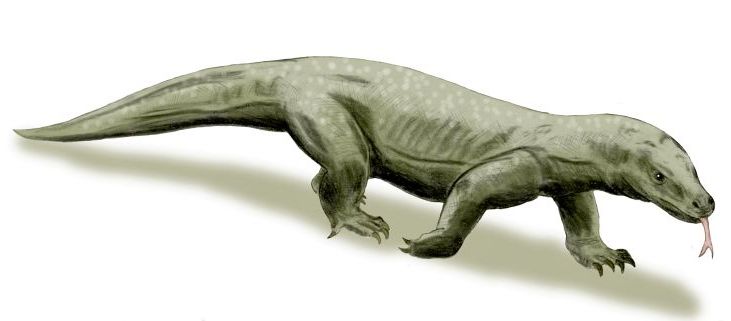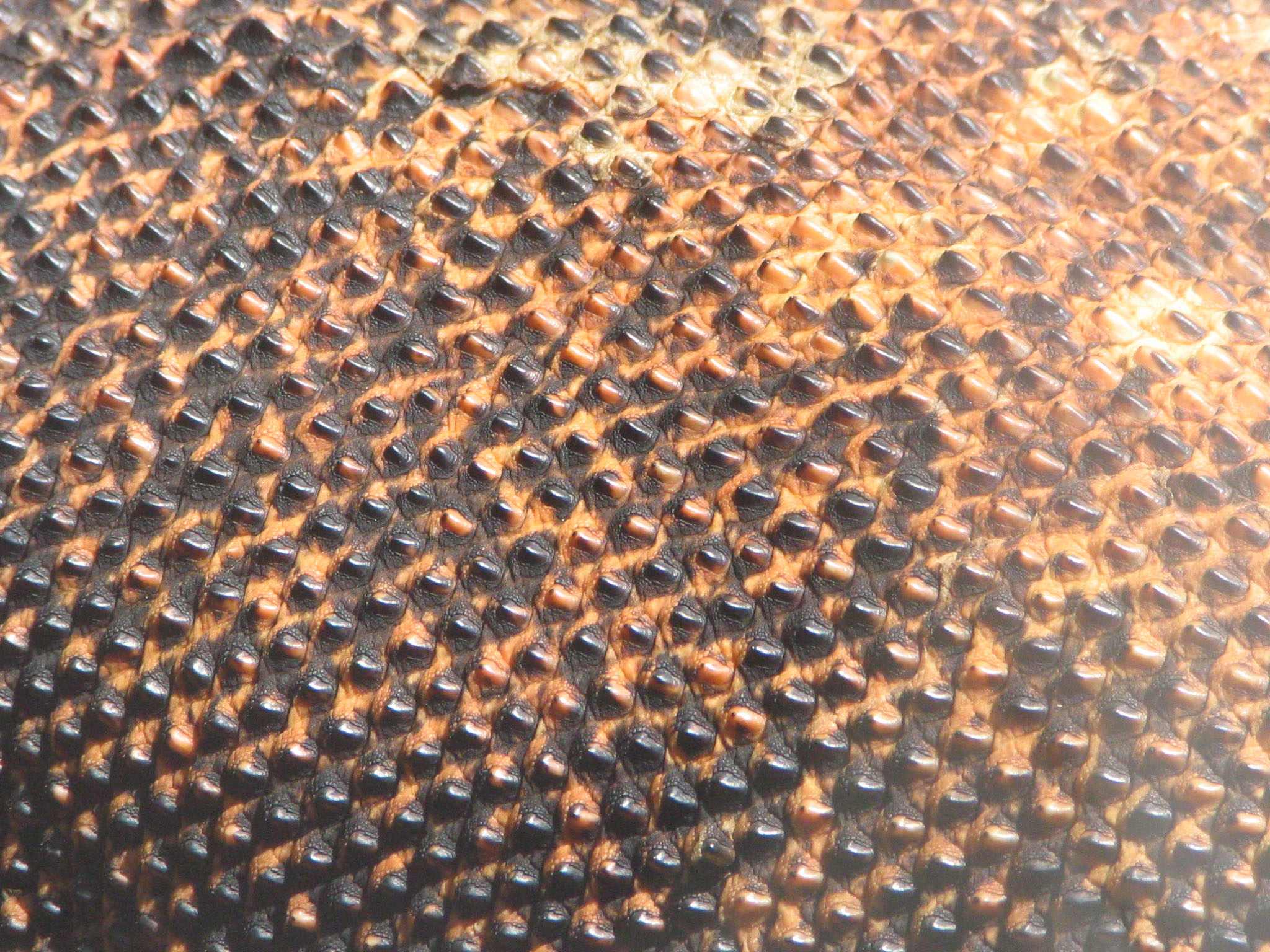A Komodo Dragon avoids the hot, tropical sun by finding shade under a tree.
(Copyright Lee Krystek, 1998)
You pause from hiking down the mountain to enjoy the sunset. Below lies a serene tropical beach and above a cloud forest. Around you are hills covered with savanna. In the ravines between the hills are monsoon forests. An amazing range of environments, you think to yourself, for an island only twenty miles long and ten miles wide.
Suddenly from the thick grass nearby a buck bolts and runs across your path. You are startled, but soon recover. After all, it is only a deer, and in a few seconds your heart rate drops back to normal. Still, something is not right. You have the feeling you are being watched. A feeling of dread. The hairs on the back of your neck suddenly stand on end. But you don't see anything.
Then you notice a smell. Unpleasant. Very unpleasant. You hear a sound in the nearby grass. You turn to look, and then it happens. The grass flies apart and something comes at you. Reptilian with cold, dead eyes. It's big. Very big. Twice your size from its ugly head to its massive tail and more than your weight. The creature's jaws open to display a set of inch-long serrated teeth dripping with deadly, infectious saliva.
The speed of this monster is incredible. Before you can even move it is upon you, its wide mouth biting down on your thigh...
What is this? A scene from the next film installment of Jurassic Park? No, the above can really happen and has really happened on the small Indonesian Island of Komodo. A bit of remote land where dragons dwell. They are the largest lizards in the world, the Komodo Dragons.
Cryptozoological Surprise
Cryptozoological Surprise
The discovery of the Komodo Dragons (Varanus komodoensis) is one of the cryptozoological surprises of the 20th century. Before 1912 the species was completely unknown and large lizards were thought to be extinct. Then, in that year, a party of pearl fishermen anchored at an almost entirely-unknown isle in a chain of islands called the Lesser Sundas. The fishermen brought back stories of an enormous, prehistoric creature living there. The island's name was Komodo.
An expedition followed from the Buitenzorg Zoological Museum in Java. A report about the dragons was published, but received little attention in the years leading up to World War I. It wasn't until 1926 that an expedition from the American Museum of Natural History, under the leadership of W. Douglas Burden, traveled to this remote island to further investigate the dragons and, if possible, bring some back alive.
The expedition discovered that the stories were true. The largest of these lizards measured over ten feet from nose to tail. The males were the top predator on the island, capable of killing a water buffalo several times its weight. The Burden expedition, with considerable difficulty, managed to bring home twelve dead specimens and two live lizards.
Venom or Toxic Bacteria? For years scientists thought that the Komodo Dragon did not poison its victims, but that its fearsome bite infected the animal with septic bacteria that slowly weakened and killed it. A recent study by led by Dr. Bryan Fry from the University of Melbourne, however, showed that the Dragon does have venomous glands in its mouth. The venom keeps the victim's blood from clotting at the wound leading to a drop in blood pressure. The loss of blood and the lower the blood pressure weaken the animal and cause it to eventually stop moving so the Dragon can safely approach and finish it. Fry believes that this specialized bite and venom shortens the contact the Dragon has with its victim allowing it to take much larger prey than might otherwise be expected. |
The Komodo dragons still live on Komodo today and have also been discovered on several neighboring islands. Though there are as many dragons alive today as in 1912, they are still considered an endangered species because they have such a small habitat that an ecological disaster, like a single volcanic eruption, might wipe them out.
Dangerous?
Dangerous?
Are the dragons dangerous to humans?
Yes. A Swiss tourist who sat down to relax while the rest of his tour group went onward was attacked and eaten by a dragon. All that was left was a piece of his camera. In March of 2009 an Indonesian fisherman was killed when he trespassed one of the remote islands in the Dragon's habitat in search of fruit. Though incidents are only few in number, that might be because the dragons live in such isolated locations. The Island of Komodo has only 800 human inhabitants and double the number of dragons. Most of the other islands where the dragons live have no permanent human residents at all.
The dragons can eat up to 80 percent of their own weight in a single sitting. Their attack strategy is to wait in ambush, then rush forward and tear a single large bite from the victim. The victim soon collapses due to blood loss. Though most Komodo dragons prefer wild bore or deer as their meals, they will try to attack and consume almost every other animal they can find, including other dragons (Interestingly enough for reasons scientists still don't understand, the dragons are not susceptible to infections from the bites of other Komodos).
When the first expeditions landed on the island they recorded the largest male dragons to have a top weight of around 300 pounds. More recent studies have indicated that this figure is high,. probably due to the a substantial amount of undigested food in those specimens' stomachs. A more typical weight for the largest dragons is probably around 160 pounds. Though the Komodo's can see fairly well, they do most of their hunting based on smell. Also a dragon can detect the smell of carrion from a distance of several miles when the wind is right. Although they will hunt when they have to, these giant lizards are more than happy to consume an already dead animal when they come across one.
Komodos are very fast for short sprints and can scramble up a hill as fast as a man can run on level ground. They have huge curved claws and teeth similar in shape to a Tyrannosaurus Rex's. Like a snake they can stretch their jaws to swallow large chunks of their victims. The Komodo's defense includes a thick skin with heavy folds that make the lizard look as if it is wearing a suit of chain mail armor. They are also one of the smartest lizards and their eyes seem to hold a primal, but clear intelligence.
Cold Blooded Killer
Why are Komodos the top predators on the island instead of an animal like the tiger? Scientists think that it has to do with the creatures's metabolism. The Komodo Dragon, like most reptiles, is cold-blooded (scientists continue to debate whether dinosaurs were cold-blooded). This means it doesn't maintain a constant body temperature, but is dependent on the sun to warm it up enough in the morning so it can take on vigorous activity.
Tigers are warm-blooded and maintain a constant body temperature at all times. This allows them to be active no matter what the temperature or time of day.
Animals who are warm-blooded burn much more energy than cold-blooded ones. This means they must eat more. Scientists think that islands like Komodo are just too small and have too few prey animals to feed a population of warm-blooded, high-energy tigers, but can support the lower energy demands of the cold-blooded dragons.
Even Bigger Lizards
So are the Komodos the largest lizards out there? Fossil finds in Queensland, Australia, indicate that the Komodo Dragon had a much larger cousin, Megalania prisca, in the prehistoric past. Megalania was more than twenty feet in length and weighed more than 1000 pounds. Though it sounds like a dinosaur, it was a giant lizard. Unlike the dinosaurs, Megalania lived at a time when humans were present and undoubtedly Megalania consumed some Homo sapiens.
This gigantic lizard lived during the Pleistocene period. It made its debut about 1.5 million years ago and disappeared around 19,000 years ago. Or did it?
There have been sightings of large lizards in the Australian outback for some time. In July 1979, cryptozoologist Rex Gilroy was called to a freshly-plowed field by a farmer. Across the field were 30 or so tracks from what looked like an enormous lizard. While most of the tracks had been ruined by rain, Gilroy was able to make a plaster cast of one that had been preserved. The footprint looked surprisingly like something that might have been made by a Megalania.
Other incidents include a farmer who saw a lizard moving along the edge of his field. Using a set of fence posts as a guide, the farmer estimated the animal's length at twenty to twenty-five feet. In 1961 three woodcutters were scared by a lizard they thought to be twenty feet long.
The largest known Australian lizard is Varanus giganteus, a relative of Megalania and the Komodos. At six feet long and with a weight of thirty to forty pounds, though, it seems too small to explain these reports.
So are there giant lizards still out in the wilds of Australia? The only way of knowing for sure is for somebody to bring one back, dead or alive. The Komodo dragon surprised science once with its existence. Perhaps the Megalania will too.
Copyright Lee Krystek, 2010
KOMODO DRAGONS
- The scene takes place on a __________________ beach with hills around covered with____________.
- The island is________________ miles long and ____________miles wide.
- At first, you don’t see _______________, then you notice a very _______________ smell.
- And you see the creature with _________-long teeth dripping with deadly _________saliva.
- This has really happened on the small ______________ of Komodo in ________________
- The dragons are the _________________lizards in the world.
- Before 1912 the dragons were completely ___________and thought to be __________________.
- Pearl __________brought back stories of an enormous _____________creature living on the island.
- In1926,W.Douglas ______________led an expedition from the American Museum of _______________.
- He wanted to bring some ________________back ________________.
- The largest lizards were over _______________feet long and capable of killing a water_____________
- The Burden expedition brought home 12 ______________specimens and _________live lizards.
- The dragons still ____________on the island and are still considered an _______________species.
- Dragons are _______________to humans: a __________tourist was __________and eaten by a dragon.
- The island of Komodo has ____________________inhabitants and _____________dragons.
- Dragons prefer ______________bore or deer but can also eat other ___________________.
- The largest male dragons can weigh ___________pounds but a more typical is probably around _______________ pounds.
- Komodos are very____________ for short sprints and can run as fast as a ________________.
- They have huge curved _____________and teeth similar to a ___________________Rex’s.
- The Komodo dragon is ___________-blooded like most reptiles , so it is _______________ on the sun to warm up its temperature.
Webquest réalisé par J.L Normand, Collège de Valdahon
http://catice.ac-besancon.fr/anglais/pdf/Microsoft_Word__KOMODO_DRAGONS.pdf
http://catice.ac-besancon.fr/anglais/pdf/Microsoft_Word__KOMODO_DRAGONS.pdf
Megalania
| Megalania | ||||||||||||||||||||
|---|---|---|---|---|---|---|---|---|---|---|---|---|---|---|---|---|---|---|---|---|
 | ||||||||||||||||||||
| Klasifikasi ilmiah | ||||||||||||||||||||
| ||||||||||||||||||||
| Nama binomial | ||||||||||||||||||||
| Megalania prisca (Richard Owen, 1859) |
Megalania adalah spesies biawak raksasa yang telah punah. Spesies ini merupakan salah satu megafauna yang ada di Australia selatan, dan telah menghilang sekitar 40.000 tahun yang lalu.
Deskripsi
Panjang tengkorak Megalania diperkirakan 76 cm. Panjang badan Megalania panjangnya 3,5 meter. Sementara ada yg ditemukan sepanjang 7 meter.
Megalania yang selamat
Di Papua Nugini, dan di Australia ada beberapa laporan Megalania yang selamat.http://id.wikipedia.org/wiki/Megalania






Tidak ada komentar:
Posting Komentar